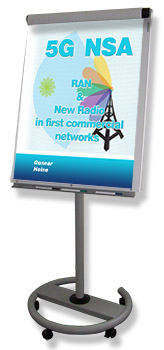 5G NSA: RAN & New Radio in first commercial networks
5G NSA: RAN & New Radio in first commercial networks
[2.5-day course, Euro 2,350.- (net) per participant]
 Training Course Description
Training Course Description
- This course addresses the needs of technical engineering staff who require a thorough understanding of 5G with clear focus on NSA-implementations. Still, also the majority of stand-alone related topics, especially in the PHY-layer are taken care of in detail.
- This course has been designed to meet the requirements of both: engineering experts to design and test 5G NSA related equipment, in particular on the UE-side and operations staff who require detailed knowledge about 5G NSA network configuration.
- The course starts out with a wrap-up of general 5G-topics like performance, time schedule and overview of technical enhancements.
- This chapter ends with a detailed analysis of NSA <=> EN-DC and the specifics of NSA-operation, especially in the protocol stack and the setup and combination of 4G-frequencies with 5G-frequencies, both FR1 and FR2.
- The whole next chapter is dedicated to RF and PHY-issues of 5G. Starting with a thorough analysis of the specifics of bands in FR1 < 1 GHz, up to 6 GHz and FR 2 > 6 GHz, we describe the particularities of the different subcarrier spacings and how and when they can be deployed.
- We continue with a detailed analysis of example bands like bands N78 / N258 for Europe or bands N5 / N260 for the US-market. Together, we calculate the maximum throughput for each example, considering the transmission bandwidth and the different subcarrier spacings.
- Next, we investigate IMD-related issues of NSA-operation and means to mitigate these issues.
- We also dedicated quite some focus on the analysis of the 5G TDD slot format and which implications and restrictions apply.
- This chapter leaves no questions unanswered w.r.t. channels and signals in 5G with clear focus on physical channels and physical signals, e.g. PSS and SSS and the SS-block.
- Finally, this chapter provides an introduction into LDPC and polar coding with a performance related comparison between LDPC on one hand and convolutional and turbo coding on the other hand
- Focus of the next chapter is on the PHY operation in 5G, clearly highlighting the differences between stand-alone and non-stand-alone operation.
- We start with a detailed analysis of the cell search procedure in 5G but continue with the description of PDCCH-operation in 5G, introducing BWP and CORESETS. This part ends with a short presentation of all currently defined DCIs.
- We continue with the random access procedure in 5G, pointing out differences between 4G and 5G.
- Next comes the analysis of Hybrid-ARQ in 5G, pointing out the operation itself and the differences between uplink and downlink HARQ and between HARQ in 4G and in 5G.
- Focus of the next chapter is on mMIMO. Initially, we clarify the terminology and differentiate mMIMO from 2D-MIMO, from beamforming and from spatial multiplexing.
- Then we use practical animations to clarify how beamforming operates physically and how antennas look like to enable beamforming.
- We take a look on practical antenna designs for mMIMO and which performance gain to expect through beamforming depending on different constraints.
- The final chapter is dedicated to the actual operation and signaling to manage NSA-operation. Clear focus is on the radio interface and RRC-signaling but we also investigate the signaling on the terrestrial interfaces, in particular on X2 and S1.
- The course ends with the analysis of signaling procedures like SgNB-addition, SgNB-modification and SgNB-release and present and investigate real-life logfiles and extracts.

Some of your questions that will be answered
- How precisely does option 3x operate and how does it differ from other options?
- How does cell search work with 5G? How is it different between stand-alone and non-stand-alone?
- Which bands 4G / 5G are combined with MR-DC in different parts of the world?
- To which degree can beamforming mitigate the additional attenuation from operation in the 3.X GHz bands or even in millimeter wave bands?
- How do active antennas look like and operate for 5G operation?
- Which number of antenna ports provides the optimum performance under which conditions
- What is vertical beamforming and when does it make sense to deploy it?
- Under which conditions can Inter-Modulation-Distortion (IMD) jeopardize NSA-operation and which options exist to mitigate these RF-related problems?
- When will the UE display the 5G icon to the user
- What are the implications of deploying different subcarrier spacings with NR?
- Which additional problems arise from TDD-operation in cellular vs FDD-operation?
- What is the meaning of the GSCN and the SS-block pattern?
- How can NR deploy beam-centric operation already in idle mode?
- Why is there no more DC-subcarrier?
- What are self-contained TTI and dynamic TTI
- Which reference signals does NR use and how is this different from 4G?
- Which performance gain to expect from mMIMO with more than 8 antenna ports on the network side?
- How does uplink beamforming operate?
- What are the NR- and MR-DC - specific contents of a UE-Radio-Access-Capability Message
- How is a 5G cell added to an existing RRC-connection?
 Pre-Requisites
Pre-Requisites
- The students need to have basic understanding of 5G.
- Besides, the students need to be able to interpret ASN.1 PER-unaligned logfiles
- The students must possess detailed understanding of LTE, especially of the PHY-layer.
 Training Course Target
Training Course Target
- The students need to have basic understanding of 5G.
- Besides, the students need to be able to interpret ASN.1 PER-unaligned logfiles
- The students must possess detailed understanding of LTE, especially of the PHY-layer.
 Training Course Duration
Training Course Duration
- 2.5 days
v1.000
ℹ️ Try out the updated search below!
Search:
More Info:
Detailed ToC of this training course
Schedule of this training course
Buy this book
INACON eBooks
Please have a look at our full offer

